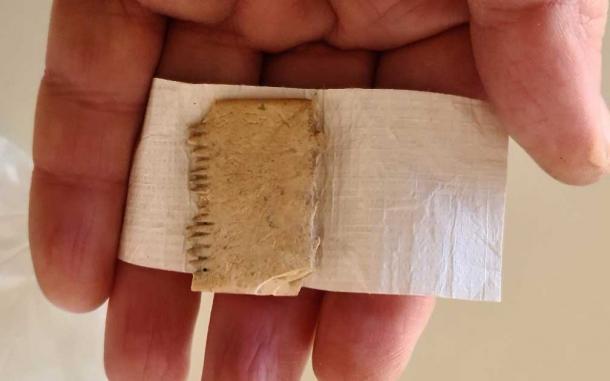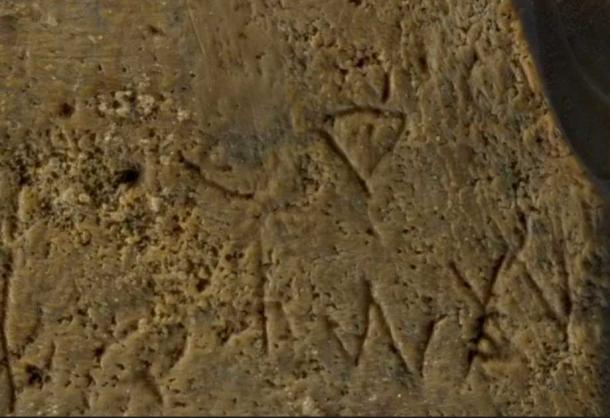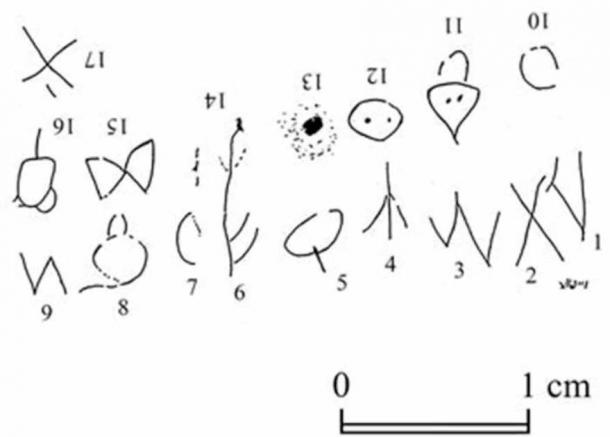
Oldest Written Sentence Found Inscribed on Ancient Head-Lice Comb
One would expect the oldest written words found during archaeological excavations to be carved into the face of a stone tablet, or perhaps into the surface of an ancient stone monument. But they can instead be found in a most unlikely place, which is on the surface of a personal care object that was recovered during an excavation in central Israel at the site of the second millennium BC Canaanite city-state of Lachish.
This object was, of all things, a double-edged ivory head-lice comb, which would have been used to help vanquish a feared parasite that can pass easily from person to person once it gains a foothold in someone’s home. And the message delicately carved into the ivory comb’s surface, which is the oldest known example of the written word in the earliest known alphabet, was entirely appropriate to the object that featured it. It read as follows:
“May this tusk root out the lice of the hair and the beard.”

The comb itself is a diminutive in size. (Daniel Vanstub/JJAR)
The completion of the translation of this remarkable good-luck wish was just announced in the open-access Jerusalem Journal of Archaeology, by a team of Israeli archaeologists with spent more than a year deciphering the tiny letters found on the comb.
“The inscription is very human,” study co-author Dr. Yosef Garfinkel, an archaeologist at the Hebrew University of Jerusalem who worked on the Lachish excavations, told the Guardian. “You have a comb and on the comb you have a wish to destroy lice on the hair and beard. Nowadays we have all these sprays and modern medicines and poisons. In the past they didn’t have those.”
- The A to Z of Alphabet Origins and the Most Ancient Written Languages
- The Armenian Alphabet, A Vision From God

The right side of the comb (Dafna Gazit / Israel Antiquities Authority)
A Head-Scratching Discovery
The ivory comb, which despite holding an inscription is only one inch by 1.4 inches (3.5 by 2.5 centimeters) in size, was actually discovered in 2017. But incredibly, it was only last year that the thin and tiny engravings on the object were finally noticed. A careful analysis of the inscription revealed it was written in ancient Canaanite script, which is the earliest alphabet ever found in the historical record.
The alphabet and its written language that accompanied it were invented approximately 3,800 years ago. The ivory comb that contains the Canaanite script has been dated to around that time, give or take a century or two, so it seems the comb´s inscription provides an early example of this legendary language being put to use.
“The comb’s inscription is written in the style that characterized the very earliest stage of the alphabet’s development,” confirmed Dr. Daniel Vainstub, an archaeologist from Ben-Gurion University and the new study´s lead author, in an interview with the Times of Israel.
The comb has been linked to the earliest Canaanite settlement at Lachish, which was formed in the 17th century BC, or not more than 200 years after the written language of the Canaanites was created. This was about four centuries before Israelites migrated to the land of Canaan in search of an area to settle.
- Ancient Alphabetic Script Found in Israel Fills Gap in Historic Record
- From an Ox to an “A”: The Ancient Egyptian Origins of the Latin Alphabet

Rendering of the 17th century BC inscription in early Canaanite script from Lachish (Daniel Vainstub/JJAR)
Deciphering the Tiny Ancient Script
The words on the ivory comb are extraordinarily tiny. The letters in the seven words are between one and three millimeters tall, which is equivalent to one-tenth of an inch or less. The artist who created them delicately etched them into the comb’s ivory surface in upside-down rows, as a result of his having flipped the comb in his hand to find blank space. The letters become progressively smaller toward the end of the first row, and in the second row the very last word features one letter etched below the row (the engraver had little room to work with).
Despite the sentence’s miniscule size and relatively down-to-earth message, its discovery represents a true historical milestone. As the study authors explain in their Jerusalem Journal of Archaeology article, the words on the comb “for the first time provide us with a complete, reliable sentence in a Canaanite dialect, written in a Canaanite script.”
The words also confirm that head lice were a problem in the Middle Bronze Age Levant, even for the elite (ivory combs were luxury items reserved for the wealthy and influential).
The ancient comb was a fine item at one time, having been made from an expensive imported material. But after having been buried in the ground for more than 3,000 years, it is worn, eroded and toothless now. Its design shows it once had six widely spaced teeth on one side, for removing tangles in the hair, and 14 narrowly spaced teeth on the other side, which were made to pull out lice and their eggs.
When examined under a microscope, the comb was found to be covered with the hardened outer membranes of tiny head lice in their nymph stage, which suggests it was indeed an effective remedy for lice infestations.
The Alphabet Revolutionizes Written Communication
Writing was invented in Mesopotamia and Egypt more than 5,000 years ago. But the earliest written languages didn’t use letters. Instead, they included hundreds of different symbols and signs that represented syllables in some cases and entire words in others. These written languages took much time and effort to learn, and that made them inefficient purveyors of information meant for the masses (or even for most elites, for that matter.)
It wasn’t until around 1,800 BC that one of the Semitic-speaking populations of the Levant, a people known to history as the Canaanites, developed the first form of what modern observers would recognize as a true alphabet. This alphabet was used for several centuries in the region, and it was eventually standardized by the Phoenicians in ancient Lebanon. This unique innovation was the forerunner of ancient Greek and Latin, and is the most distant ancestor of all the modern written languages used in most of Europe and in the Americas today.
This ancient alphabet-based language was flexible enough to communicate about almost anything to a wide range of people. Its subjects could be scientific or philosophical, or entirely mundane, as was the case with the message found on the ivory comb.
“The fact that this inscription is about ordinary life is especially fascinating,” said Christopher Rollston, a professor of Northwest Semitic languages at George Washington University. “Throughout human history lice have been a perennial problem. We can only hope that this inscribed comb was useful in doing that which it says it was supposed to do—root out some of these pesky insects.”
Top image: First Canaanite writing scratched onto an ivory comb. Source: Dafna Gazit/Israel Antiquities Authority
By Nathan Falde















